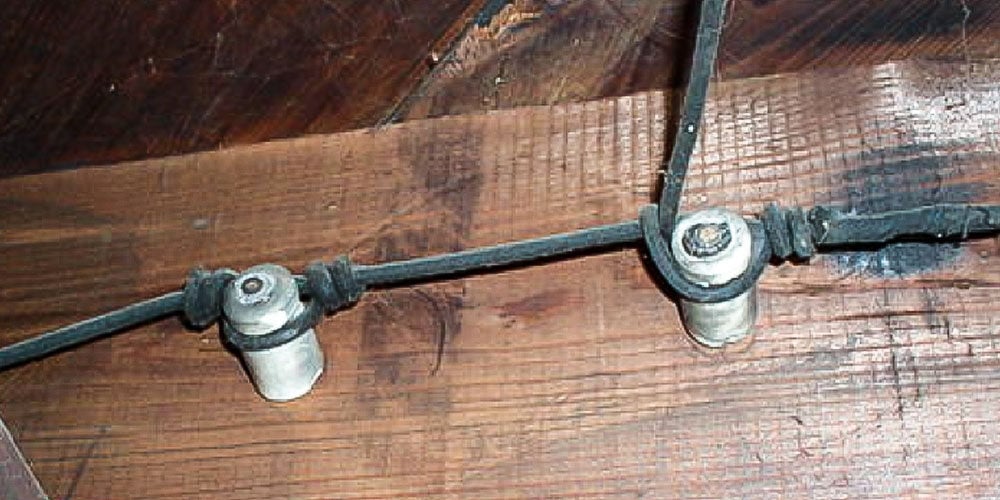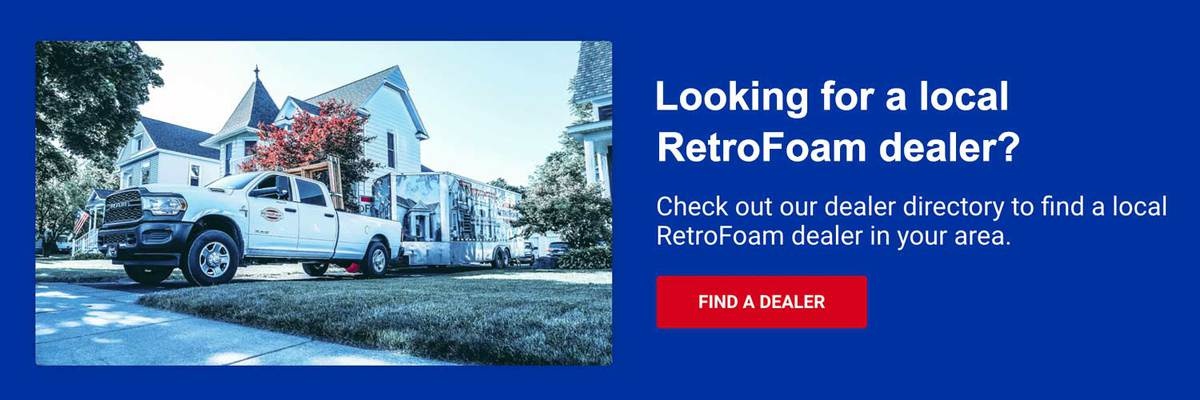Knob and Tube Wiring and RetroFoam: Can You Add Insulation to an Older Home?


When it comes to older homes, the topic of knob and tube wiring frequently pops up, especially when homeowners are considering installing modern insulation like RetroFoam.
One of the most common questions we hear is, can RetroFoam insulation be added into walls with knob and tube wiring. The short answer is yes – physically, it can be installed. However, before you get too far into the process, there are some safety and regulatory concerns that need to be addressed.
In this article, we’ll dive into everything you need to know about knob and tube wiring, how it impacts insulation installation, and what steps you should take to ensure a safe and successful project.
Let’s get started.
What is Knob and Tube Wiring?
Before we jump into insulation specifics, it’s important to understand what knob and tube wiring actually is.
This type of electrical wiring was common in homes built from the 1880s to the late 1940s. Named after the ceramic knobs and tubes used to insulate and route the electrical wires, this method was considered advanced at the time.
The system used single-insulated copper wires, which were strung along the framework of a house through porcelain insulators.
Characteristics of Knob and Tube Electrical Wiring
- No Ground Wire: Unlike modern electrical systems, knob and tube wiring does not have a ground wire, which adds a level of risk in terms of electrical safety.
- Free Air Cooling: The wires were spaced apart and routed through walls, attics, and floors in open air to prevent overheating.
- Ceramic Insulators: Porcelain knobs and tubes were used to hold the wires in place and keep them from coming into contact with combustible materials.
Due to the lack of grounding and outdated materials, knob and tube wiring isn’t up to modern electrical code in many areas. While it’s still present in some older homes, it’s often a source of concern for homeowners looking to upgrade their insulation, particularly with injection foam products like RetroFoam.
Can RetroFoam Be Installed with Knob and Tube Wiring?
Now, let’s address the big question: Can RetroFoam be installed in a home that has knob and tube wiring?
The answer is yes, it physically can be installed, but that doesn’t necessarily mean it should be. There are several factors to consider before proceeding, including safety concerns, local building codes, and conversations with your insulation contractor and an electrical inspector.
Safety Concerns with Old Knob and Tube Wiring
Knob and tube wiring, while innovative in its time, poses a number of safety risks in today’s world.
Over the years, the wiring can degrade, and if the wires are knocked loose or damaged, there’s a potential for live electrical wires to come into contact with surrounding materials. This is where the real concern lies when installing RetroFoam.
- Wires Knocked Loose: If the foam installation process causes any disturbance to the wires, they could become dislodged from the ceramic tubes that are meant to keep them safe.
- Live Wire Exposure: Damaged or loose wiring could lead to live electrical wires coming into contact with building materials in the walls, which could create a hazardous situation.
These potential hazards mean that while you can install RetroFoam in a home with knob and tube wiring, it’s critical to take extra precautions.
Should You Install RetroFoam with Knob and Tube Wiring?
This is a more complicated question and one that should be answered only after a detailed conversation with your insulation contractor and local electrical inspector.
Installing RetroFoam in walls that contain knob and tube wiring can be done depending on several factors.
- Condition of the Wiring: If the knob and tube wiring in your home is still in good shape and hasn’t been disturbed or modified over the years, your inspector may give you the green light to install foam insulation.
- Local Codes: Some areas have building codes that strictly prohibit installing insulation in walls that contain knob and tube wiring. Before any work is done, your contractor and inspector should check local regulations to ensure you’re in compliance.
- Electrical Inspection: It’s often a good idea to have an electrician inspect your wiring before proceeding with insulation installation. If the wiring is in poor condition or poses any risks, it may need to be replaced or repaired before insulation can be added.
The Installation Process: What to Expect
If you’ve gotten the all-clear from your inspector and electrician, then you can proceed with the installation of RetroFoam.
In terms of the actual installation process, the steps will be very similar to any other home, regardless of whether or not knob and tube wiring is present.
- Injection Process: RetroFoam is typically injected into the wall cavities through small holes drilled into the exterior of the home. These holes are then sealed once the foam has been injected.
- No Change in Procedure: The presence of knob and tube wiring doesn’t change the way the foam is installed. Whether your home has a brick, aluminum, or wood exterior, the process is the same. However, extra care will be taken to ensure that the wires are not disturbed during installation.
Your insulation contractor will likely work closely with your local inspector to ensure everything goes smoothly. In some cases, the inspector may want to come out after the installation to double-check that everything is in order, or they may request that an electrician inspect the wiring one last time.
What if the Inspector Doesn't Approve the Installation?
If your inspector decides that it’s not safe to install RetroFoam due to the condition of your old knob and tube wiring, you’ll need to explore alternative options.
The most common solution is to replace the outdated wiring with a modern electrical system that meets today’s safety standards. While this can be an investment, upgrading your wiring will not only allow you to safely install insulation but will also improve the overall safety and functionality of your home’s electrical system.
Benefits of Upgrading Your Wiring
- Increased Safety: Replacing knob and tube wiring eliminates the risk of electrical fires and other hazards associated with outdated electrical systems.
- Modern Convenience: With modern wiring, you can safely use today’s electronics and appliances without worrying about overloading your electrical circuits.
- Energy Efficiency: Modern wiring is more energy-efficient, which can lower your utility bills and improve the overall performance of your home’s electrical system.
Once your wiring has been upgraded, you can move forward with the installation of RetroFoam or any other type of insulation without any concerns about safety or code violations.
Adding RetroFoam Insulation to Your Existing Walls
If you live in a home with knob and tube wiring, adding modern insulation like RetroFoam can be a great way to improve your home’s energy efficiency and comfort.
However, it’s essential to approach the project with caution. Always consult with an experienced insulation contractor and your local electrical inspector to ensure that your home’s wiring is in good condition and that the installation meets local building codes.
While it is possible to install RetroFoam in a home with knob and tube wiring, safety should always be your top priority. By taking the time to evaluate your wiring and working closely with professionals, you can make an informed decision about whether or not to proceed with your insulation project.
If you’re ready to move forward, be sure to check out our Find a Dealer page to connect with a RetroFoam dealer in your neck of the woods.
Related Articles
Is RetroFoam Safe to Have in Your Home?
Will RetroFoam Insulation Cause Corroded Electrical Wires in the Wall?
Repairing Plumbing and Fishing Electrical Wire Through Insulated Walls with RetroFoam
About Eric Garcia
Eric brings his knowledge and training in building science, training in spray and injection foams from the manufacturers, more than eight years installing foam insulation, as well as selling and managing in the foam insulation industry. He is also BPI and Dale Carnegie certified and has taken several building science courses, including air sealing and building envelope. Eric is the Professor of Foam on our educational YouTube series Foam University. Even when Eric is off he is usually still “working” or thinking about work, but when he can get away he enjoys camping, hiking, hunting, and woodworking.



